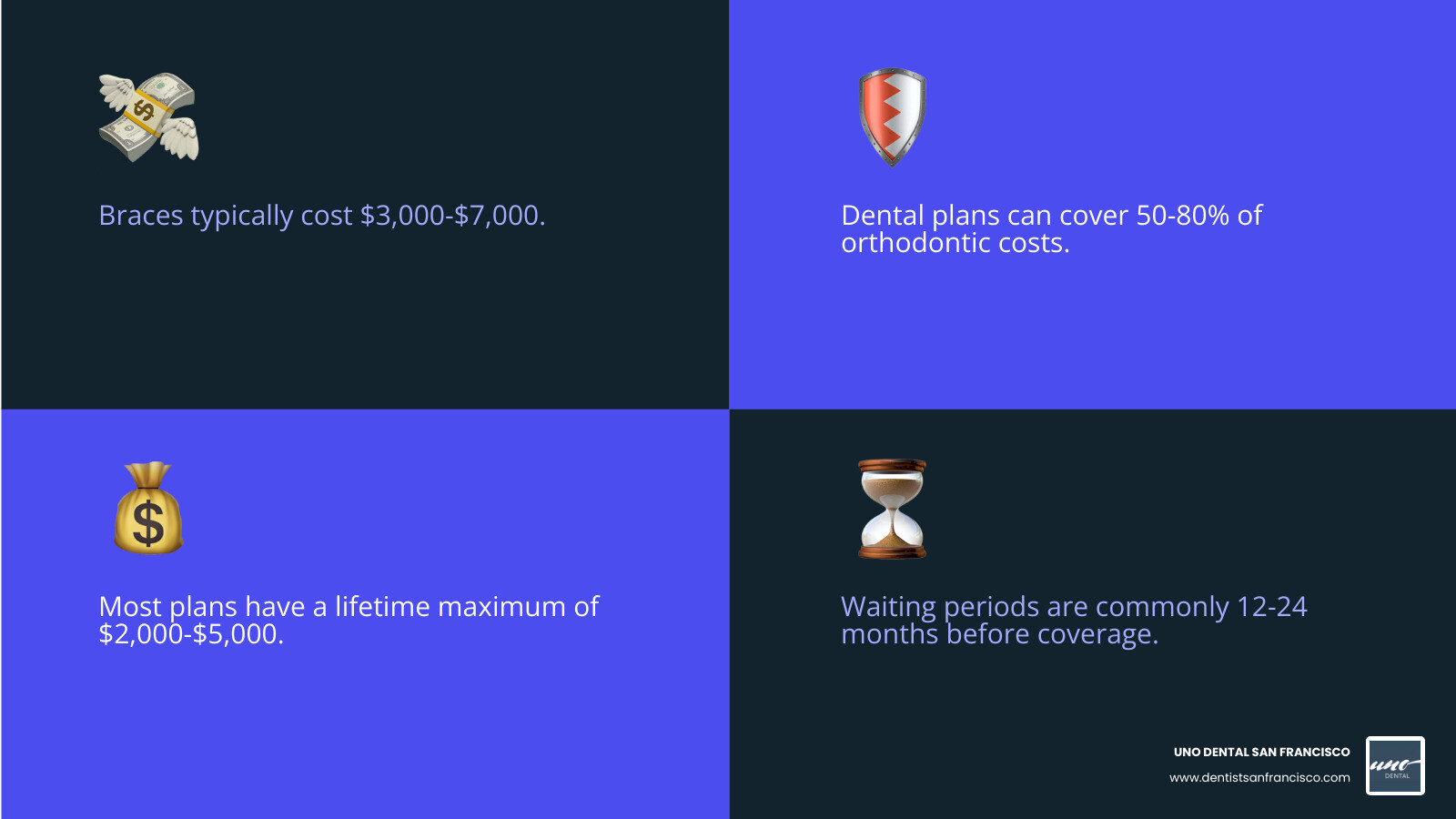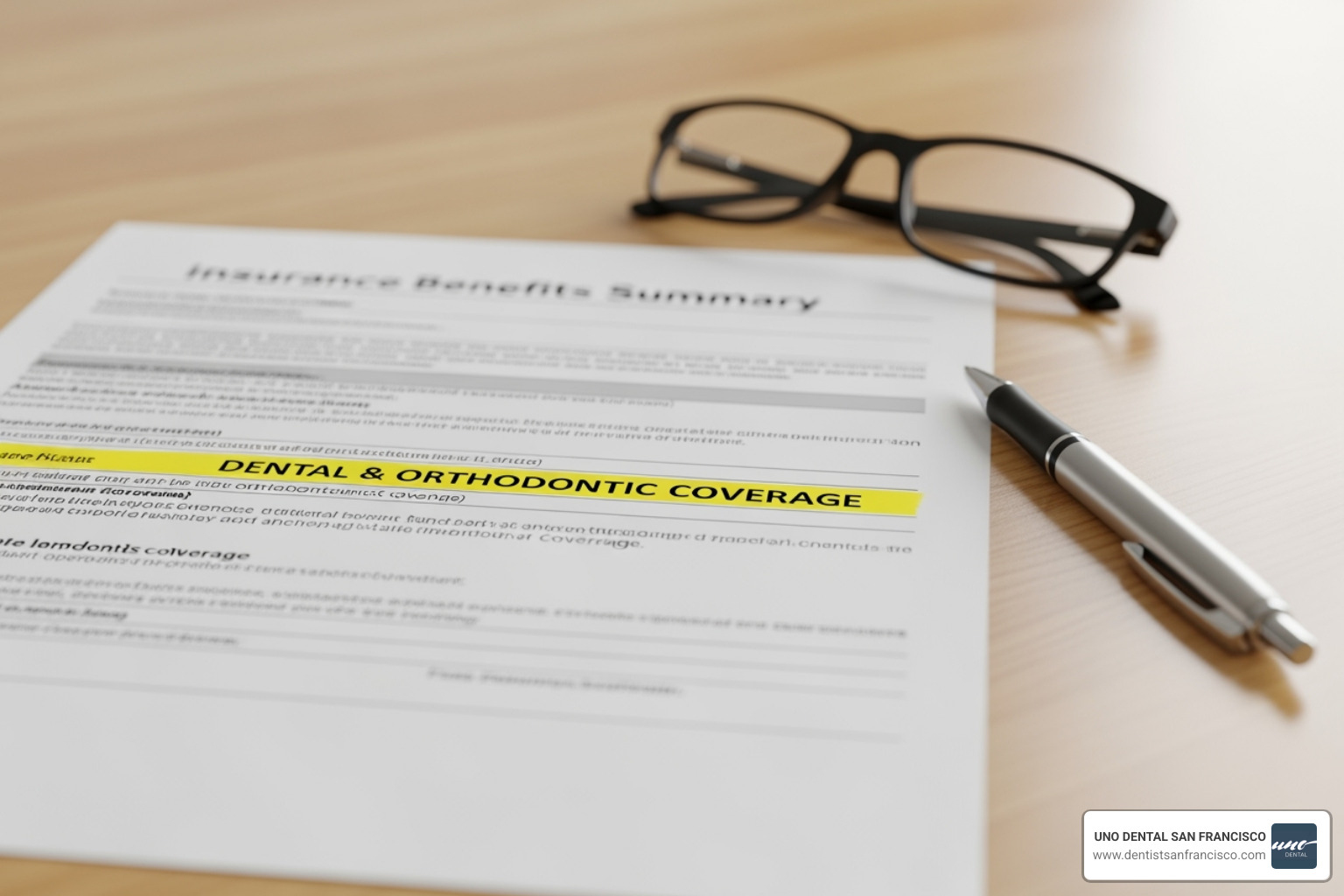
Why Finding the Right Dental Plan for Braces Is Essential
Medically reviewed and manually reviewed for accuracy by Mohammad Aghiad Kandar, DDS — UNO DENTAL SAN FRANCISCO
A dental plan for braces can mean the difference between an affordable path to a straighter smile and thousands in out-of-pocket costs. With braces costing between $3,000 and $7,000, the right insurance is crucial for making orthodontic treatment accessible.
Quick Answer: What to Look for in a Dental Plan for Braces
- Orthodontic coverage with 50-80% reimbursement rates
- Lifetime maximum of $2,000-$5,000 per person
- Short waiting periods (typically 12-24 months)
- In-network orthodontist options in your area
- Coverage for both traditional braces and clear aligners
The reality is that many dental plans have lifetime limits for orthodontic coverage, often $2,000 to $5,000 per person. Without proper planning, families face significant costs that a better plan could have covered.
Finding a plan that supports your orthodontic journey, whether for traditional braces or modern alternatives like clear aligners, makes treatment affordable and stress-free.
As Mohammad Aghiad Kandar DDS at UNO DENTAL SAN FRANCISCO, I've helped countless patients steer insurance for orthodontic treatment. With over 15 years of experience, I've seen how the right dental plan for braces transforms a patient's journey from financial stress to a confident smile.
Understanding How Dental Insurance Covers Orthodontics
Navigating dental insurance can feel complex, but understanding the basics makes it much clearer how your dental plan for braces can work for you.
Medical necessity versus cosmetic treatment is the first hurdle. If your orthodontic treatment addresses a functional problem—like severe bite issues causing jaw pain or difficulty chewing—it's more likely to be covered. If the treatment is purely for cosmetic reasons, most plans won't contribute.
At UNO DENTAL SAN FRANCISCO, we help patients document medical necessity when it applies, which can be the difference between substantial coverage and paying entirely out of pocket.
When a plan covers orthodontics, typical coverage percentages range from 50% to 80% of approved costs. If your braces cost $5,000 and your plan covers 60%, you'd receive $3,000 from insurance, leaving you with a $2,000 balance.
Lifetime maximums are a critical detail. Unlike annual benefits that reset, orthodontic coverage has a lifetime limit per person, typically $2,000 to $5,000. This is the total amount your insurance will ever pay for orthodontic treatment. For example, even if your plan covers 80% of a $6,000 treatment ($4,800), a $2,500 lifetime maximum means you'll only receive $2,500. Understanding this limit upfront is key.
Deductibles and co-payments work as they do with other insurance. You'll pay a deductible (often $50-$200) before coverage begins, after which you are responsible for your co-payment portion.
Advantageously, orthodontic coverage usually operates separately from your annual maximums for general dental care. Your $1,500 annual limit for cleanings and fillings won't be affected by your orthodontic benefits. This is helpful since treatment often spans multiple years. To better understand your options, check out our complete guide to orthodontic options.
What Costs to Expect for Braces
Braces typically cost between $3,000 and $7,000, with complex cases reaching $8,000 or more, especially in high-cost areas like San Francisco.
Several factors influence your final cost. Traditional metal braces are often the most affordable, while ceramic braces, lingual braces, and clear aligners command premium prices. The complexity and duration of your treatment also play major roles.
Even with excellent insurance, out-of-pocket expenses are almost inevitable. With treatment costs often exceeding the typical $2,000-$5,000 lifetime maximum, you'll likely pay a significant portion yourself. If your treatment is $6,000 and your plan has a $2,500 lifetime max, you'll pay at least $3,500 out of pocket. This reality makes finding the right plan crucial.
For comprehensive information about different types of braces, the General information on braces resource provides valuable details.
Common Exclusions and Limitations
Even the best dental plan for braces has limitations that are important to understand.
Waiting periods are the most common roadblock, requiring you to be enrolled for 6 to 24 months before orthodontic coverage begins. Starting treatment during this period means you'll pay entirely out of pocket.
Pre-existing condition clauses are less common for orthodontics, as the waiting period usually serves as the main barrier.
Age limits can be frustrating for adults. Many family plans consider braces a pediatric benefit, cutting off coverage at age 18 or 19. Adults often need specialized plans that explicitly include adult orthodontic benefits.
Retainer coverage is another common limitation. While initial retainers are typically included in the treatment cost, replacements usually aren't covered by insurance.
Cosmetic exclusions mean that if your insurance deems the treatment purely cosmetic, coverage will be denied.
These limitations highlight why reviewing any potential plan is essential. At UNO DENTAL SAN FRANCISCO, we help patients understand their policy details. For more on maintaining your results, our Teeth After Braces Complete Guide offers comprehensive guidance.
Finding the Right Dental Plan for Braces
Choosing the right dental plan for braces is easier when you understand your options and know what features matter most.
PPO (Preferred Provider Organization) plans offer the most flexibility in choosing your orthodontist. You can visit any licensed provider, though you'll save more by staying within their network. These plans typically cover a percentage of orthodontic costs after your deductible and have separate lifetime maximums for orthodontics.
HMO/DHMO plans often have lower premiums but require you to use their network. You choose a primary care dentist who must refer you to an in-network orthodontist. Instead of percentages, you pay fixed co-payments, but your provider choice is limited.
Dental discount plans aren't insurance. You pay an annual fee for discounted rates from participating providers. There are no waiting periods, deductibles, or annual maximums, but they reduce your costs rather than covering them.
The choice between employer-sponsored and individual plans often comes down to availability and cost. Employer plans usually offer better benefits and lower premiums. If that's not an option, individual plans are available directly from providers or through health insurance marketplaces, though they may have higher premiums and less comprehensive coverage.
Here's how these plan types stack up for orthodontic coverage:
| Feature | PPO Plan | HMO/DHMO Plan | Dental Discount Plan |
|---|---|---|---|
| Network | Flexible, can go out-of-network (higher cost) | Restricted to in-network providers | Network of participating dentists |
| Cost | Higher premiums, deductibles, co-insurance | Lower premiums, fixed co-pays, no deductibles | Annual membership fee, discounted services |
| Claim Process | Dentist submits claims, percentage paid | Fixed co-pay paid directly to provider | Pay discounted fee directly to provider |
| Orthodontics | Often covered (percentage, lifetime max) | Limited coverage, usually requires in-network | Discounts on orthodontic services |
| Waiting Period | Common for major services (6-24 months) | Less common | None |
Key Features to Look for in a dental plan for braces
When evaluating dental plans for orthodontic coverage, focus on these key features.
Explicit orthodontic coverage is your first non-negotiable. Don't assume any plan covers braces; you need to see it stated in the policy. Many comprehensive plans cover 50% to 80% of costs, but only if orthodontics are specifically included.
Low deductibles mean your insurance kicks in sooner. A $50 deductible versus a $200 one might seem small, but every dollar counts.
High lifetime maximums for orthodontics are crucial, as this is the total amount your plan will ever pay for braces. Look for plans offering $2,500 to $5,000 or more.
In-network orthodontist options can dramatically impact your costs. Before choosing a plan, check if quality orthodontists in your area are in-network to save thousands.
Short waiting periods are ideal. While 24 months is common for orthodontics, look for plans with 12 months or less. Some plans have no waiting periods, which is a game-changer if you need treatment soon.
Coverage for different types of braces is important. Some older plans only cover traditional metal braces, considering clear aligners cosmetic. If you want discreet options, ensure your plan covers them.
At UNO DENTAL, we know you might face out-of-pocket expenses even with great insurance. That's why we offer flexible payment solutions, including our Clear Aligner Payment Plan, to make treatment manageable.
How to Choose the Best dental plan for braces for Adults vs. Children
The patient's age makes a huge difference when selecting a dental plan for braces, as insurers view pediatric and adult orthodontics differently.
For children and teenagers, insurance is generally more generous. Most standard plans offer better benefits for pediatric orthodontics, recognizing its importance for long-term oral health, sometimes covering up to 80% of costs.
Age limitations are critical. Many plans cut off orthodontic coverage at age 18 or 19. If your teen is approaching this limit, start treatment before they age out. Some plans extend coverage to age 23 for full-time students, but always check your policy.
Two-phase treatment coverage is relevant for younger patients. If an orthodontist recommends Phase I and Phase II treatment, most plans apply both against the single lifetime maximum.
For teenagers considering clear aligners, our guide on clear aligners for teens provides custom insights for younger patients.
Adult orthodontic coverage presents different challenges. Many plans were designed when orthodontics was primarily a pediatric service, so adult coverage can be limited or nonexistent. Adults should seek plans that explicitly include adult orthodontic benefits.
Medical necessity is even more important for adults. If treatment addresses functional issues like TMJ disorders or severe tooth wear, documenting these concerns strengthens your case for coverage. At UNO DENTAL, we provide thorough documentation when medical necessity applies.
Specialized adult plans might be necessary if your current coverage excludes adult orthodontics. Some insurers offer standalone or higher-tier plans designed to include adult benefits.
Adult patients in San Francisco can find detailed information in our Adult Braces San Francisco resource, which addresses unique considerations for adult orthodontic care.
The Step-by-Step Process to Using Your Insurance for Braces
Once you have a dental plan for braces, the next step is using your benefits. This roadmap helps you steer the process smoothly.
Step 1: Initial Consultation
Your journey begins with the first appointment. During your initial consultation, we'll perform a comprehensive exam of your teeth and bite, discuss your concerns, and determine if orthodontic treatment is right for you.
This visit typically involves X-rays, photographs, and digital scans. We'll also talk about your goals, whether you're fixing a functional issue or boosting your confidence with a straighter smile.
This is the perfect time to ask about treatment duration, options, and estimated costs. If you're considering clear aligners, a clear aligner consultation lets you explore this popular alternative.
Step 2: Pre-determination of Benefits
Before starting treatment, we always recommend getting a pre-determination of benefits from your insurance company. This crucial step saves you from financial surprises.
We'll submit your proposed treatment plan and documentation to your insurer. They'll review it and send back an estimate showing what they'll cover, including your deductible, co-payment, and lifetime maximum usage.
While not a guarantee of payment, this gives you a clear picture of your expected costs and helps you budget accordingly.
Step 3: Understanding the Treatment Plan and Costs
Once we receive your insurance pre-determination, our financial coordinator will provide a detailed cost breakdown. We believe in complete transparency with no hidden fees.
We'll explain your total estimated out-of-pocket expense after insurance and go over payment schedules and financing options to make treatment affordable.
This is your opportunity to ask any remaining questions about costs or your dental plan for braces. We want you to feel comfortable with the treatment plan and financial commitment.
Step 4: The Claims Process
Working with an in-network provider like UNO DENTAL is simple. We handle the insurance paperwork, submitting all forms directly to your insurer to make the process seamless for you.
Your insurance company pays its portion directly to our office, and you're only responsible for the remaining balance. No waiting for reimbursement checks or dealing with complicated forms.
In-network vs. out-of-network providers can significantly impact your costs and convenience. Out-of-network providers often require you to pay the full fee upfront and submit claims yourself for reimbursement, which means more paperwork and potentially higher costs.
We prefer to keep things simple for our patients by working directly with insurance providers. Getting braces should be about improving your smile, not stressing over paperwork.
Frequently Asked Questions about Dental Plans and Braces
Here are answers to the most common questions about finding and using a dental plan for braces.
Can I get a dental plan if I already know I need braces?
Yes, you can get coverage, but timing is everything. Most dental insurance plans have a waiting period for orthodontic benefits, typically 6 to 24 months, before you can start treatment.
If you sign up for a dental plan for braces knowing you need treatment, you'll likely pay premiums for up to two years before using those benefits. Insurance companies use waiting periods to ensure you don't sign up, get expensive treatment, and then cancel.
This is why planning ahead is crucial. If you or your child might need braces, it's smart to secure coverage well before you need it. For orthodontics, the waiting period is the main hurdle, not "pre-existing condition" clauses.
At UNO DENTAL, we advise patients to think about orthodontic needs early, especially for children. The sooner you have coverage, the sooner benefits are available.
Does insurance cover different types of braces, like clear aligners?
The good news is that most modern dental insurance plans treat different types of braces equally. Whether you choose traditional metal braces, ceramic braces, or clear aligners, your coverage typically works the same way, with the same percentage covered and the same lifetime maximum applied.
However, there are nuances. Traditional braces are almost universally covered if your plan includes orthodontic benefits. Clear aligners are also widely covered by most current plans at the same rate. But some older or basic plans might still consider clear aligners a "premium" or "cosmetic" option and not cover it.
The key is to ask your insurance provider specifically about coverage for your preferred treatment type. Even when covered, premium options might lead to higher out-of-pocket costs if the total fee exceeds what the insurance considers "usual and customary."
We're transparent about all treatment costs at UNO DENTAL. You can learn more in our guide to the cost of clear aligners in San Francisco, and we provide detailed information about our clear aligner options in San Francisco options.
What if my insurance doesn't cover the full cost of my braces?
Insurance rarely covers the full cost of orthodontic treatment, but several strategies can make it affordable. Most families face some out-of-pocket expenses due to lifetime maximums, deductibles, and co-payments.
Flexible Spending Accounts (FSA) are a great employer-offered option. You can set aside pre-tax dollars for healthcare expenses, including orthodontics, giving you a discount equal to your tax rate. FSA funds are typically "use-it-or-lose-it" within the plan year.
Health Savings Accounts (HSA) offer more flexibility. Available with high-deductible health plans, HSA funds roll over year-to-year and can be invested.
Many dental practices, including UNO DENTAL, offer in-house financing. Our interest-free payment plans allow you to spread costs over time, making monthly payments manageable.
Third-party financing through companies that specialize in healthcare is another option. These healthcare-specific credit cards often offer interest-free periods.
The bottom line is we're committed to finding a solution that works for your budget. Cost should never be a barrier to a healthy, confident smile. We'll explore all options to create a payment plan that fits your financial situation.
Conclusion: Your Path to an Affordable, Straighter Smile
Finding the right dental plan for braces doesn't have to be overwhelming. This guide covered the essentials for making treatment affordable, from understanding coverage and lifetime maximums to navigating waiting periods and plan types.
The key takeaways are straightforward: look for explicit orthodontic coverage with high lifetime maximums, understand your waiting periods, and always request a pre-determination of benefits before starting treatment. Whether you're considering traditional braces or clear aligners, the right insurance planning can turn a large expense into manageable monthly payments.
Orthodontic treatment is a health investment, not just a cosmetic choice. Correcting bite issues, aligning crowded teeth, or addressing jaw problems prevents future complications like excessive tooth wear, gum disease, and chronic jaw pain. The benefits impact your ability to chew, speak, and maintain excellent oral hygiene for life.
A well-chosen dental plan for braces, combined with flexible payment options like FSAs, HSAs, or in-house financing, makes this crucial treatment accessible and manageable.
At UNO DENTAL SAN FRANCISCO, we understand every patient's insurance situation is unique. We take the time to review your benefits, handle the pre-authorization process, and work directly with your insurer. Our goal is to eliminate guesswork and paperwork so you can focus on achieving your healthiest, most confident smile.
We believe everyone deserves access to quality orthodontic care. Our team helps patients maximize their benefits and explore financing when needed. With our free virtual smile consultations, you can start exploring your treatment possibilities from home.
Ready to turn your smile goals into reality? Explore our approach to dental plans for cosmetic dentistry and find how we can help you steer the insurance maze while creating the healthy, beautiful smile you've always wanted.



